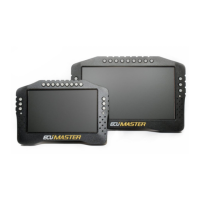It is recommended to use an interface with galvanic isolation. The CAN bus is a differential signal
bus and in most cases there is no need to connect the interface ground to the vehicle/ADU ground.
If you want to connect an interface ground, measure the potential difference of the interface and
the vehicle. Too large a potential difference can damage the device.
CAN bus
The CAN (Control Area Network) bus was developed to communicate between devices in
automotive environments. Its construction is very simple (only two wires) and its immunity to
interference is very high. In a modern car, there may be dozens of different electronic modules
communicating with the use of the CAN bus.
The ADU device has two CAN buses: the CAN1 bus is used for communication with a PC (requires
an additional interface) and devices that support 1Mbps speed.
Data frames are sent on the network. The network topology should look like the following:
In automotive applications, typical data transmission speeds on the CAN bus are 1Mbps, 500 Kbps
and 250 Kbps. Depending on the speed, the following conditions must be met:
For a speed of 1Mbps:
– the length of the connection cable between the bus and the node must not exceed 30 cm.
– the maximum bus length is 40 m
– the maximum number of nodes is 30
Page 14/137

